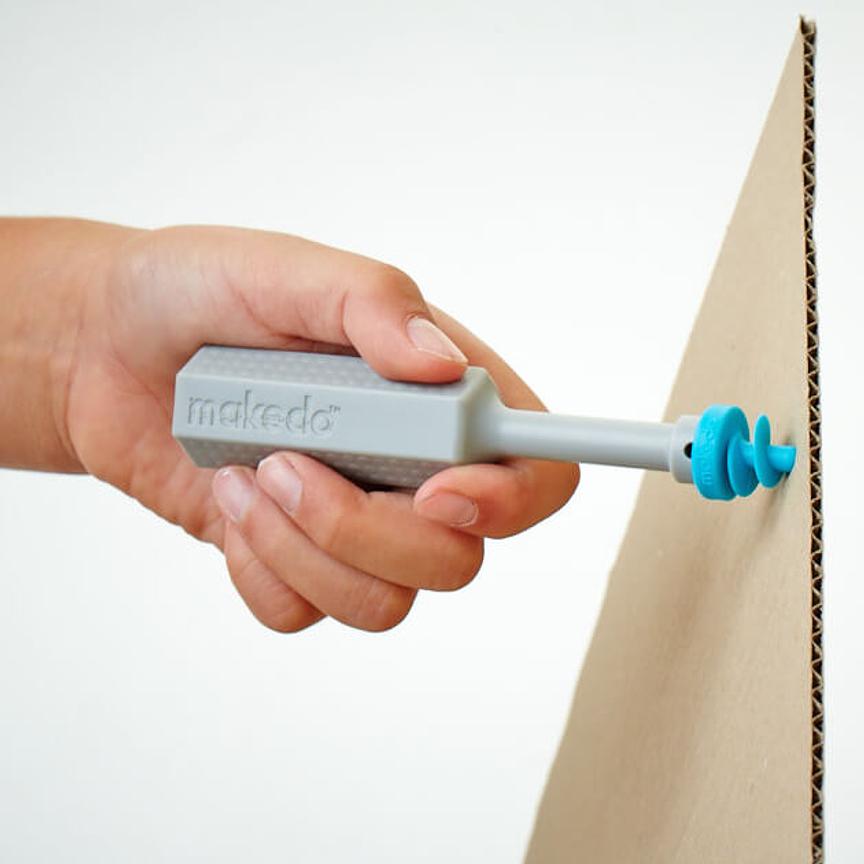Inventor and Founder of Makedo, Paul Justin was always looking for ways to drive his children’s education, love of learning and creativity. Each weekend his son would go to him with an idea of something to make; it would be anything from a robot costume to a spaceship. Frustrated with using the not so reliable sticky tape and glue to connect things, (both functionally and environmentally) he set himself a design brief to create a construction system that made it easy for children to create anything from their imagination. He wanted something that was open-ended; a construction system that taught children not what to think, but how to think. Makedo was created and has become a popular tool for cardboard construction in educational settings globally, as it promotes skills essential to 21st century learners: creative thinking, problem solving and imagination. Not to mention, it’s completely reusable.
Makedo is affordable and accessible to the global education market because the reusable tools work with cardboard; a universally available, free and unlimited building block. Cardboard is STRONG and VERSATILE; it is easily pliable by small hands and may be folded, sawed and hole punched without losing its durability. Use the SAFE-SAW to cut your cardboard into the desired shape, then grab a SCRU and SCRU-DRIVER to connect up to six pieces of corrugated cardboard.
Makedo is completely open-ended, allowing anyone to build anything they conceive. It engenders a deeper understanding of key concepts taught across a range of learning areas and aligns perfectly with STEAM curriculum. Students can apply their knowledge of STEAM concepts to real life scenarios, by using Makedo to make, play, learn and inspire. A simple mathematics lesson about mass can turn into the construction of a chair that has been designed to hold an adults weight. A drama lesson discussing stagecraft could turn into the design and construction of sets and costumes.
With Makedo, the emphasis is on process rather than outcome. Students are given a platform to explore their hypotheses in a safe and exciting way. Mistakes turn into discoveries and are cause for celebration, a way to learn more about an idea and move forward with more knowledge. Through a process of experimentation, adaptation and invention, with Makedo, ordinary cardboard becomes that imagined thing; from 'minds eye' to 'I made it'. Just Find, Make, Play, Learn and Inspire.
Makedo is great for independent learning and allows educators to step back so that students can take the lead role in their own learning. It is equally excellent for collaborative projects and enables students to work on their problem solving, negotiation and social skills. The flexibility and open-endedness of Makedo, means that students can choose at which points they would like to work together and easily assign roles, such as designer, engineer, constructor or anyone can be involved throughout. Makedo is scalable, meaning that it can be used in a classroom or even a whole school setting; community projects have taken place where amazing mazes and geodomes have been constructed on a mega scale and enjoyed by all.
If you’re looking to add breadth, depth and complexity to your cardboard construction project, it can be used in conjunction with technology rich tools, such as Makey Makey, littleBits and Hummingbird just to name a few. Additional Makedo parts can be3D printed from Thingiverse to enhance and accessorise your project. We’re always looking for new and exciting parts that our makers may design, that could be added to the Thingiverse library or a Makedo kit.

